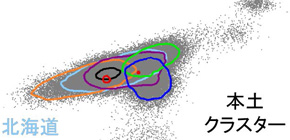
Study sheds light on recently evolved traits among Japanese descendants
Researchers centered at Osaka University identify genetic traits that evolved very recently in human history among Japanese populations
Evolution enables beneficial traits to dominate a population. Given enough time, groups exposed to different environments will eventually evolve unique adaptive traits. Knowing how environmental pressures shape human evolution can lead to a better understanding of why certain populations or ethnic groups today are predisposed to certain characteristics. In a new study published in Nature Communications , researchers centered at Osaka University conducted a large-scale genomic analysis to explore recent evolutionary events among individuals of Japanese descent.
The team performed whole-genome sequencing using 2,234 Japanese participants. As its name suggest, the technique attempts to read the entirety of a genome—all three billion letters of it. Comparing the genomes of many individuals at once makes it possible to find regions that have changed more rapidly than others—in other words, places where evolution has caused a particular genetic trait to predominate.
Not all genome sequencing studies are created equal; however, with some doing a better job of reading genomes than others.
“Whole-genome sequencing is a common technique, but our analysis achieved exceptionally ‘deep’ sequencing,” lead author Yukinori Okada explains. “This means that we collected significantly more information from each person’s genome compared with similar studies. This allowed us to identify evolutionary changes that occurred over much more recent periods of time, on the scale of the last 2,000 to 3,000 years.”
Previous studies looking at similar time scales have focused exclusively on European ancestry. In those studies, it was found that Europeans mostly experienced adaptations related to height, obesity, and the immune system. The current study supplements these findings by focusing on Japanese individuals—from an area where evolutionary pressures have had a distinct impact on adaptive traits.
“Our study is the largest high-depth sequencing study conducted to date on a non-European population,” contributing author Saori Sakaue adds. “We found that very different evolutionary traits have evolved in Japanese populations over the last few thousand years, particularly traits involved in the metabolism of alcohol, glucose, and lipids. Given the clear evolutionary differences between European and Japanese populations, we expect our findings to shed light on how different ancestries can evolve divergent traits over very short periods of time.”

Fig. 1. Genetic loci with strong recent selection pressure in the Japanese population.
(credit: Osaka University)

Fig. 2. Genetic variants with selection pressure showed regional heterogeneity in allele frequency spectra, especially at the Okinawa region.
(credit: Osaka University)

Fig. 3. Overlap of the human complex traits with selection pressure in the Japanese population.
(credit: Osaka University)
To learn more about this research, please view the full research report entitled "Deep whole-genome sequencing reveals recent selection signatures linked to evolution and disease risk of Japanese" a t this page of Nature Communications.
Related links
